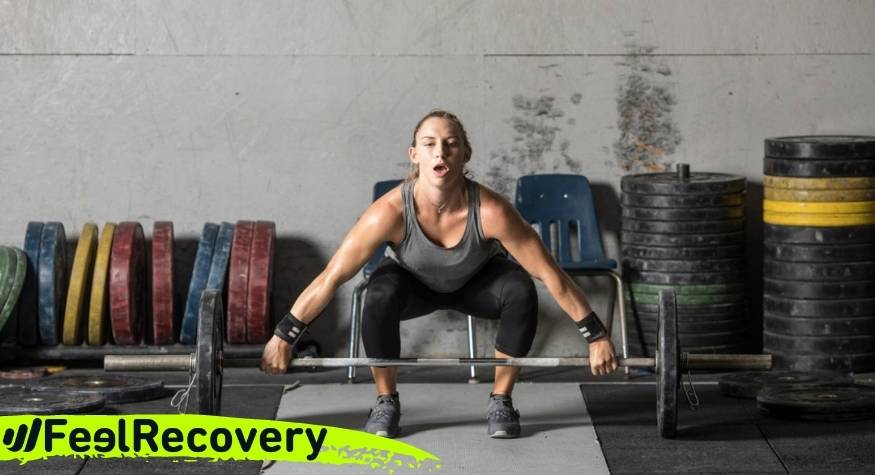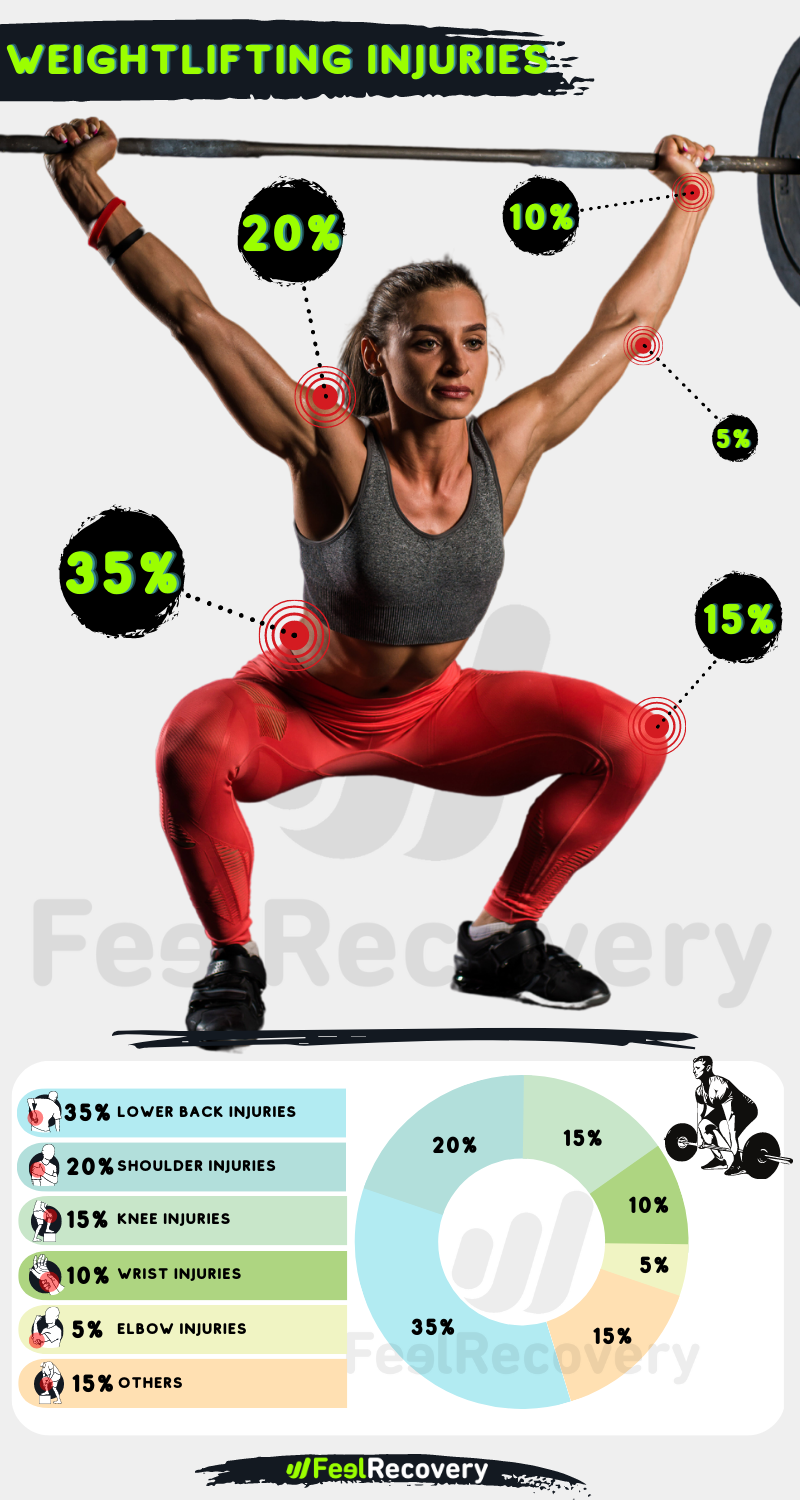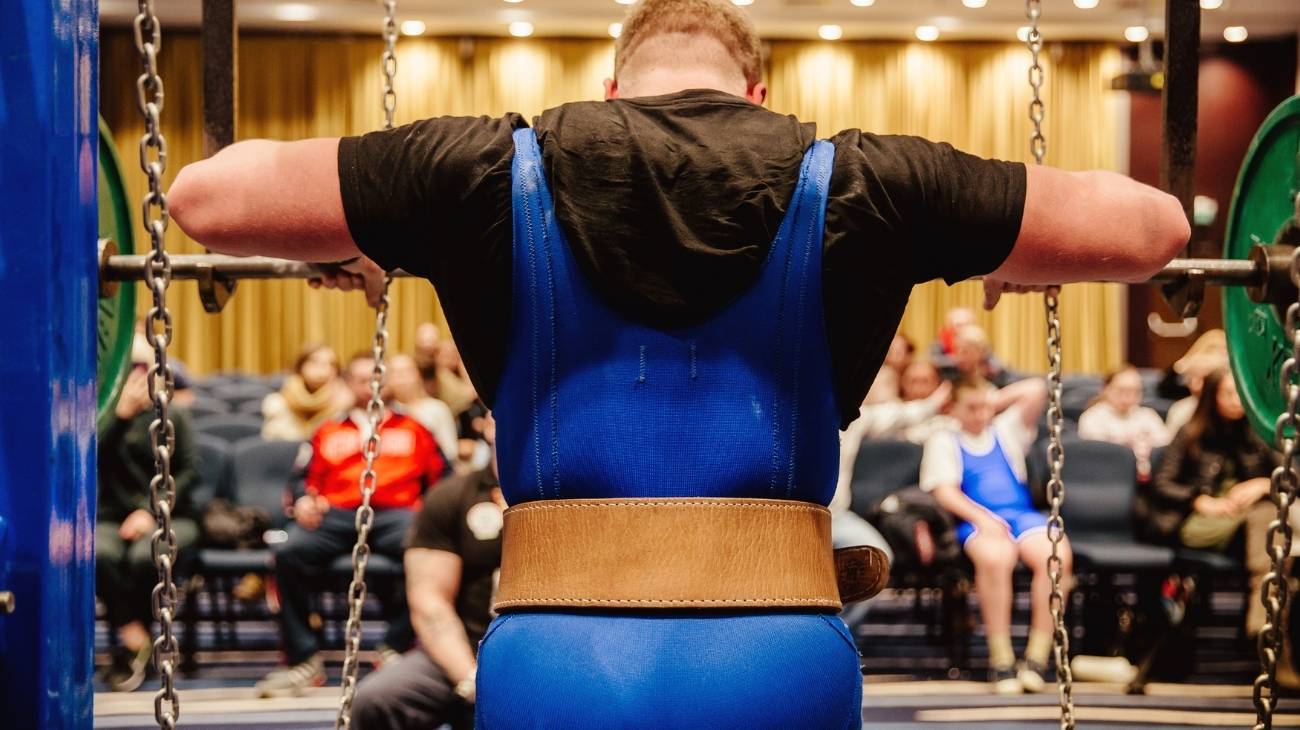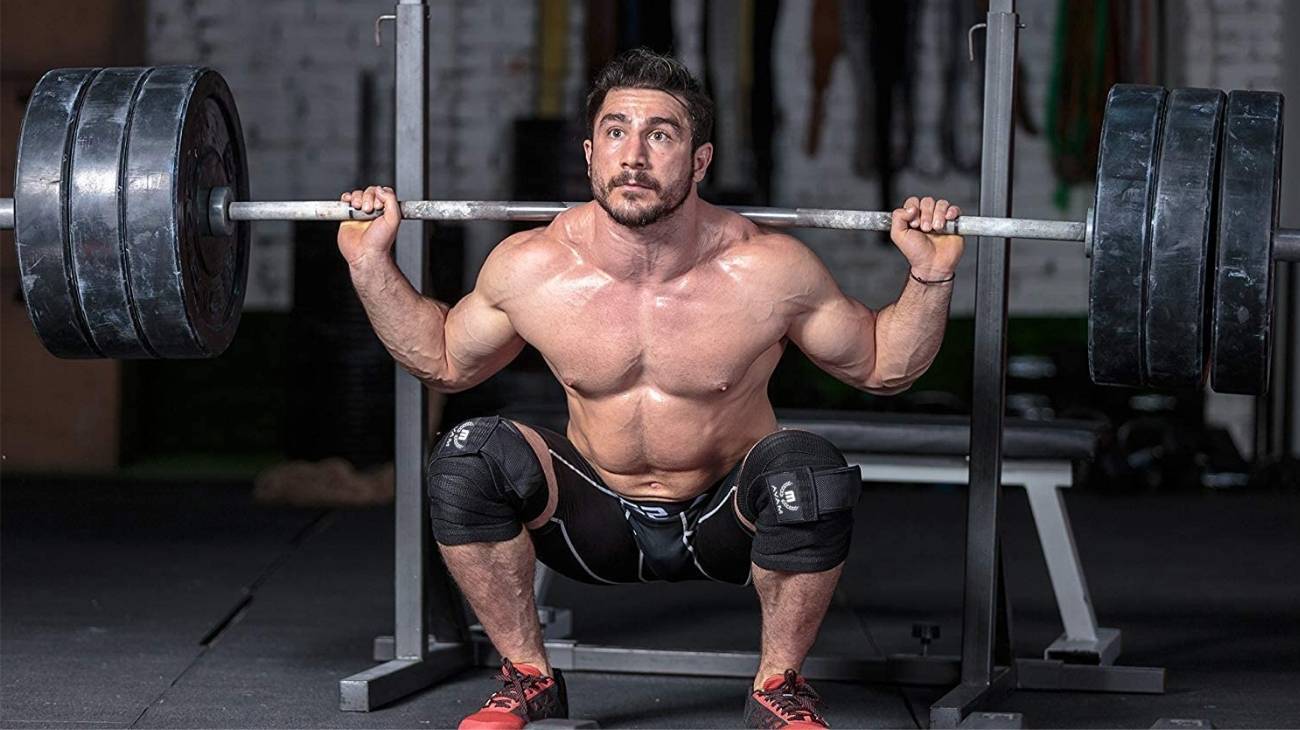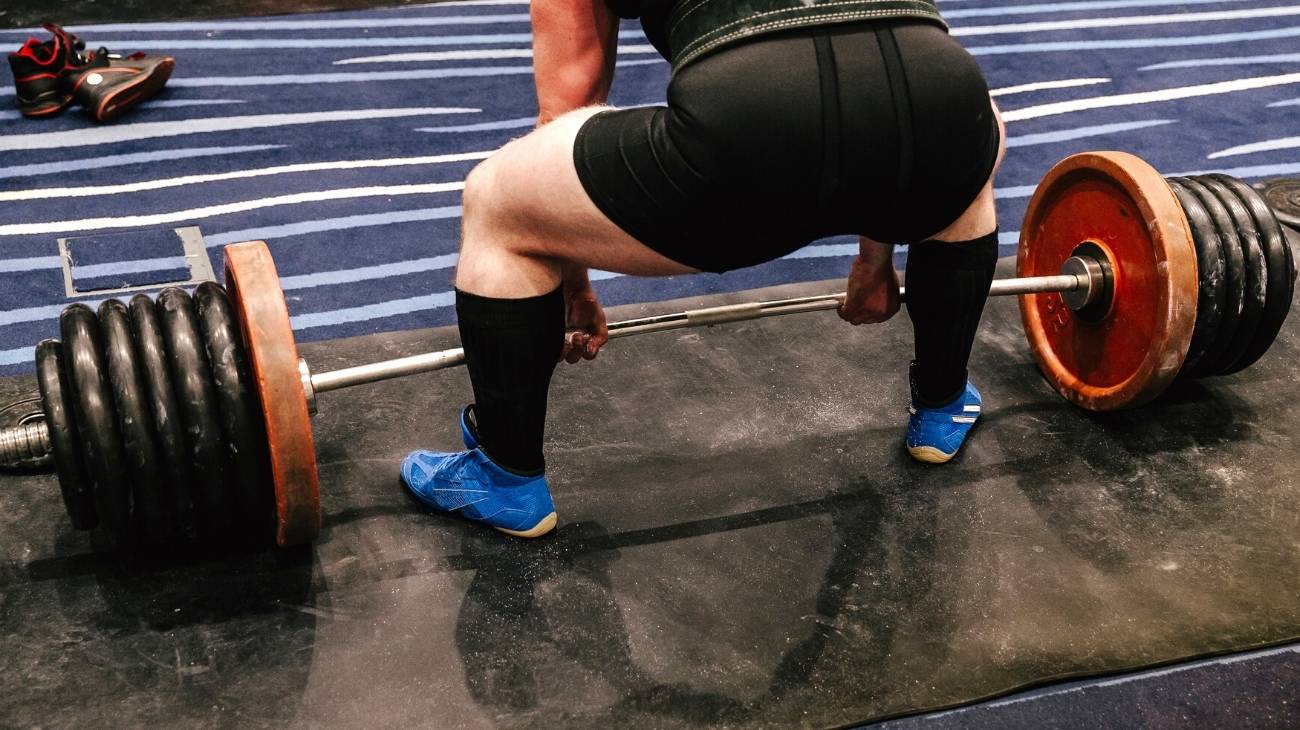The prevention of injuries is based on the selection of a training plan in accordance with the weightlifter's actual build. A weightlifter with years of training has stronger bones and stronger muscles than a novice or amateur, so the demands should not be the same.
As we want you to learn how to prevent weightlifting and gym sports injuries, here are the most common injuries that occur in strength sports and ways to prevent them according to existing training and therapies
What are the most common types of weightlifting and powerlifting injuries?
Although the number of injuries is low in weightlifting, when an injury occurs it is usually chronic, due to the high intensity of training and competition in search of the best results. Almost all weightlifting injuries occur when athletes test muscular endurance with poor technique.
Check out this list of the most common weightlifting injuries:
- Muscle contractions: It sounds obvious that muscles contract, but it is not normal for them to fail to return to a relaxed state. Muscle contractions occur when tension exceeds the endurance capacity of the muscle fibres. It is the first warning that you are not training well or that your muscles are fatigued. Most of these injuries occur in the back.
- Joint wear and tear: This is a major injury, because the joint is a complex point where various tissues and gears converge to allow mobility. If you have not paid attention to the contractions, the stress of the exercises will most likely have a negative effect on the joints. Failure of any of them will result in severe pain in the joint.
- Cartilage wear and tear: The good news is that when the cartilage starts to hurt, you should just adjust your technique and lower the amount of weight you are trying to lift again. The bad news is that when the wear and tear is advanced, and you have exhausted all medical possibilities, you should probably lower the intensity for good and become an amateur. Cartilage does not have the ability to regenerate, as muscles do.
- Tendonitis: This is the irritation and inflammation of any tendon in the human body. In weightlifting, it is common to get tendonitis in the shoulders, forearms and knees, forcing you to take breaks. Tendonitis in the forearm is caused by a poor hand grip on the Olympic bar, so practice with a light weight on the grip before trying to attach more discs to the bar. Push-ups in the arms and legs lead to an overload of work on the joints, resulting in irritation of the tendons. Besides the weight on the discs, the main cause is actually poor technique.
- Sprains: This is the extreme stretching of the ligaments that bind the bones together. Weightlifting causes an increased risk of sprains in the shoulders, elbows and knees. As mentioned above, during the various stages of lifting there is likely to be a physical imbalance and loss of mental focus, which causes the balance of the bar to fail and the joints to wobble.
- Fractures: Although these injuries are the least likely, cracks and double fractures have occurred in the forearms of athletes in competition. Usually the bone fragments do not penetrate the skin, but cause damage to the rest of the soft tissues. Again this is due to loss of balance, coupled with muscle fatigue and the high expectation of the athlete wanting to lift more load than they can actually carry.
- Dislocations: In every joint there are two bones, and a dislocation involves the separation of one of the bones from its usual place. It can also occur in the joints of the lower body. Although the wrists are more fragile joints, there are almost no cases. In a dislocation, ligaments are torn and nerves are pressed, so pain will be intense in the affected area.
- Low back pain: Most low back pain is due to contractures and tears in the psoas iliacus muscles, which is a fairly strong muscle group in the lower back. They connect the hip to the spine. Because the athlete must perform deep, 90° push-ups, there will always be a risk that the spine will suffer from poor technique, a bad warm-up and muscle fatigue. This is why weightlifting competitions allow the use of protective belts in order to reduce the likelihood of lower back discomfort.
Best products for Weightlifting injury recovery
Bestseller
-
2 Calf Compression Sleeve (Black/Gray)
$19.95 -
2 Calf Compression Sleeve (Green/Navy)
$19.95 -
2 Calf Compression Sleeve (Pink/Bordeaux)
$19.95 -
2 Elbow Compression Sleeve (Black/Gray)
$19.95 -
2 Elbow Compression Sleeve (Green/Navy)
$19.95 -
2 Elbow Compression Sleeve (Pink/Bordeaux)
$19.95 -
2 Knee Compression Sleeve (Black/Gray)
$19.95 -
2 Knee Compression Sleeve (Green/Navy)
$19.95 -
2 Knee Compression Sleeve (Pink/Bordeaux)
$19.95 -
2 Thigh Compression Sleeve (Black/Gray)
$19.95 -
2 Thigh Compression Sleeve (Green/Navy)
$19.95 -
2 Thigh Compression Sleeve (Pink/Bordeaux)
$19.95 -
Acupressure Mat and Pillow (Black/Gray)
$49.95 -
Acupressure Mat and Pillow (Green/Navy)
$49.95 -
Acupressure Mat and Pillow (Pink/Bordeaux)
$49.95 -
Acupressure Pillow (Black/Gray)
$29.46 -
Acupressure Pillow (Green/Navy)
$29.46 -
Acupressure Pillow (Pink/Bordeaux)
$29.46 -
Back Support Belt (Black)
$34.95 -
Back Support Belt (Green)
$34.95 -
Back Support Belt (Pink)
$34.95 -
Foot Massage Roller for Plantar Fasciitis (Black)
$19.95 -
Foot Massage Roller for Plantar Fasciitis (Green)
$19.95 -
Foot Massage Roller for Plantar Fasciitis (Pink)
$19.95 -
High Density Foam Roller for Muscle (Black/Gray)
$29.95 -
High Density Foam Roller for Muscle (Green/Navy)
$29.95 -
High Density Foam Roller for Muscle (Pink/Bordeaux)
$29.95 -
Ice Massage Roller Ball (Black)
$39.95 -
Ice Massage Roller Ball (Green)
$39.95 -
Ice Massage Roller Ball (Pink)
$39.95 -
Microwave Heating Pad for Back Pain Relief (Extra Large) (Hearts)
$29.95 -
Microwave Heating Pad for Back Pain Relief (Extra Large) (Oxford)
$29.95 -
Microwave Heating Pad for Back Pain Relief (Extra Large) (Sport)
$29.95 -
Microwave Heating Pad for Neck & Shoulder Pain Relief (Hearts)
$24.95 -
Microwave Heating Pad for Neck & Shoulder Pain Relief (Oxford)
$24.95 -
Microwave Heating Pad for Neck & Shoulder Pain Relief (Sport)
$24.95 -
Pack 2 In 1 Foam Roller High + Soft Density (Black/Gray)
$29.95 -
Pack 2 In 1 Foam Roller High + Soft Density (Green/Navy)
$29.95 -
Pack 2 In 1 Foam Roller High + Soft Density (Pink/Bordeaux)
$29.95 -
Sacroiliac Support Belt (Black)
$24.95 -
Sacroiliac Support Belt (Green)
$24.95 -
Sacroiliac Support Belt (Pink)
$24.95 -
Shoulder Support Brace (Black)
$24.95 -
Shoulder Support Brace (Green)
$24.95 -
Shoulder Support Brace (Pink)
$24.95 -
Soft Density Foam Roller for Recovery (Black)
$29.95 -
Soft Density Foam Roller for Recovery (Green)
$29.95 -
Soft Density Foam Roller for Recovery (Pink)
$29.95 -
Trigger Point Massage Stick (Black)
$14.95 -
Trigger Point Massage Stick (Green)
$14.95 -
Trigger Point Massage Stick (Pink)
$14.95
List of weightlifting and gym training injury prevention methods
There are many therapies and recommendations in this sport to prevent chronic injuries, which are the most frequent in weightlifting. Learn about the different clinical and alternative therapies to become more resistant.
Warming up properly
As we know, most injuries are generated because your body is not well prepared, the warm-up is a vital stage of any training. Choose your exercise routine well, preferably mobility and general stretching exercises. Start by walking or cycling, then go for a gentle jog, the idea is to be active.
Move your joints, do strides and practice all the steps of the deadlift without discs on the bar. Muscle memory is a detail to take into account because weightlifting is a mechanical sport. With all these recommendations, you will get your muscular structure ready.
Finish your workouts with a cool-down
Just as it is important to warm up, it is important to cool down your body to allow your blood flow and heart rate to return to the calm they were before training. Suddenly stopping your workout will prevent proper muscle recovery and can lead to muscle contractures and cramps.
Take care of your body, by cooling down you allow the soft tissues to be prepared for the next day's training. In competitions, warm-up should last up to five minutes before stepping onto the platform.
Good nutrition and hydration
All diets are based on a balanced intake of protein, fat and carbohydrates. The percentage of fat should represent 30% of the food. The majority of the diet should be made up of protein (30%) and carbohydrates (40%), not forgetting micronutrients, vitamins and minerals such as magnesium, zinc and iron which are essential for muscle health.
In terms of hydration, water is always best drunk every 20-25 minutes and don't wait until your body is dehydrated when it gets thirsty. You should avoid being full of water because then you will feel a feeling of heaviness in your stomach which will limit your power in training. The diet will have favourable results on your flexibility and elasticity by improving the overall condition of your body.
Improve your fitness
Weightlifting is all about lifting as much weight as possible and not just about looking big. Muscle hypertrophy is a slow process that seeks to increase muscle mass in order to obtain greater strength, although in maximum or explosive strength sports such as weightlifting, muscle development is only an initial part of the athlete's process, since the aim is to generate greater intramuscular nerve connections so that the lifts are more explosive and heavier.
Although it is a strength sport, it is also important to practice endurance exercises to strengthen your cardiac capacity and avoid tissue fatigue. In case you didn't know, the weight of the athlete is taken into account when the scores are defined, which means that when there is a tie, the athlete with the lowest body weight wins.
Sports massage
A good massage will bring the muscles, tendons and ligaments back to their normal state. It is normal after training to feel tense and stiff, as if you have knots in your forearm and thighs.
As a physiotherapy technique, massages will allow the tensions to disappear and the blood flow to improve. You will notice that your body is more relaxed and ready for the next training session. You should not receive massages in case of sprains and fractures, touching the tissues in these circumstances is contraindicated.
Use of heat and cold therapies
When to use cold and when to use heat on the body? It all depends on your purpose as an athlete. For example, if you need to recover from injuries, prevent them from getting worse and reduce pain, cold is best.
When you want to keep some part of your body warm, without sweating, when you need to increase blood flow and open capillaries, heat is the way to go. Heat will make it easier for nutrients to reach damaged tissues and facilitate their regeneration.
Use of compression garments
In weightlifting, few items of clothing are allowed. Socks are the only authorised accessories, apart from a protective belt. In training, you can wear a jersey that covers the torso and arms.
Compression garments make you perform better, your muscles are less fatigued, your body temperature is higher and you are at less risk of injury. The only disadvantage is that, by overusing them, you will make your body too used to them and become dependent on them.
Use of acupressure therapies
Only a qualified therapist can apply this holistic and sports-only technique. It is similar to acupuncture, but does not require special needles to achieve the same results.
Using the fingers and palms of the hands, and sometimes using Lacrosse balls, the specialist touches local points, trigger points and meridians along the body to make the energy flow better. When the energy builds up, the person feels a tension that limits their movements and abilities.
Use of thermotherapy and cryotherapy
Both techniques are developed with long-term goals such as recovery from sprains, better control of metabolism, and improved muscle and tissue performance. Thermotherapy uses temperatures up to 58°C and its use does not exceed five to six seconds.
There is full body equipment or equipment that covers some of the extremities, which allows the use of heat to be controlled. As for cryotherapy, it is applied at temperatures averaging -130°C and by freezing harmful cells in the body are eliminated. There are already devices that apply both therapies without the need to change location or body position.
Using the right equipment
The first and biggest investment you should make is to have the right weightlifting shoes. These are not the same as the average sports shoe. Their material makes them more resistant to the weight of the body and the weight of the discs, they also have 3 centimetres of additional elevation in the sole and give stability to the body to avoid imbalances. It is not necessary to cover the ankles, these joints do not suffer in this sport because they remain immobile most of the time.
References
- Aasa, U., Svartholm, I., Andersson, F., & Berglund, L. (2017). Injuries among weightlifters and powerlifters: a systematic review. British journal of sports medicine, 51(4), 211-219. https://bjsm.bmj.com/content/51/4/211.short
- Mazur, L. J., Yetman, R. J., & Risser, W. L. (1993). Weight-training injuries: common injuries and preventative methods. Sports Medicine, 16, 57-63. https://link.springer.com/article/10.2165/00007256-199316010-00005
- Keogh, J. W., & Winwood, P. W. (2017). The epidemiology of injuries across the weight-training sports. Sports medicine, 47(3), 479-501. https://link.springer.com/article/10.1007/s40279-016-0575-0
- Siewe, J., Rudat, J., Röllinghoff, M., Schlegel, U. J., Eysel, P., & Michael, J. P. (2011). Injuries and overuse syndromes in powerlifting. International journal of sports medicine, 32(09), 703-711. https://www.thieme-connect.com/products/ejournals/abstract/10.1055/s-0031-1277207
- Hamill, B. P. (1994). Relative safety of weightlifting and weight training. J Strength Cond Res, 8(1), 53-7. https://paulogentil.com/pdf/Relative%20Safety%20of%20Weightlifting%20and%20Weight%20Training.pdf
- Brown, E. W., & Kimball, R. G. (1983). Medical history associated with adolescent powerlifting. Pediatrics, 72(5), 636-644. https://publications.aap.org/pediatrics/article-abstract/72/5/636/49023/Medical-History-Associated-with-Adolescent
- Bengtsson, V., Berglund, L., & Aasa, U. (2018). Narrative review of injuries in powerlifting with special reference to their association to the squat, bench press and deadlift. BMJ Open Sport & Exercise Medicine, 4(1), e000382. https://bmjopensem.bmj.com/content/4/1/e000382.abstract
- Ángel Rodríguez, M., García-Calleja, P., Terrados, N., Crespo, I., Del Valle, M., & Olmedillas, H. (2022). Injury in CrossFit®: a systematic review of epidemiology and risk factors. The Physician and Sportsmedicine, 50(1), 3-10. https://www.tandfonline.com/doi/abs/10.1080/00913847.2020.1864675
- Mundt, D. J., Kelsey, J. L., Golden, A. L., Panjabi, M. M., Pastides, H., Berg, A. T., ... & Hosea, T. (1993). An epidemiologic study of sports and weight lifting as possible risk factors for herniated lumbar and cervical discs. The American journal of sports medicine, 21(6), 854-860. https://journals.sagepub.com/doi/abs/10.1177/036354659302100617
- Reddell, C. R., Congleton, J. J., Huchingson, R. D., & Montgomery, J. F. (1992). An evaluation of a weightlifting belt and back injury prevention training class for airline baggage handlers. Applied ergonomics, 23(5), 319-329. https://www.sciencedirect.com/science/article/abs/pii/0003687092902935

